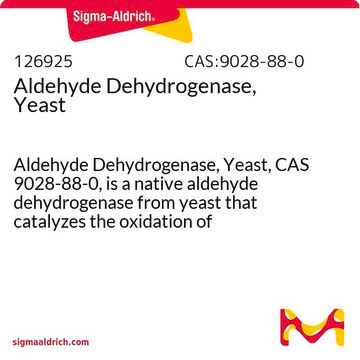10171832001
Roche
Aldehyde Dehydrogenase
from yeast
Synonim(y):
Aldehyde dehydrogenase
Zaloguj sięWyświetlanie cen organizacyjnych i kontraktowych
About This Item
Polecane produkty
pochodzenie biologiczne
yeast
Poziom jakości
Postać
lyophilized
aktywność właściwa
~20 units/mg protein (At 25 °C with acetaldehyde as the substrate.)
opakowanie
pkg of 250 U
producent / nazwa handlowa
Roche
optymalne pH
8.75
powiązane choroby
cancer
temp. przechowywania
2-8°C
Powiązane kategorie
Opis ogólny
Aldehyde dehydrogenase (ALDH) is a soluble enzyme and its activity depends on potassium ions and cysteine. The family of ALDH comprises of 19 genes in human. ALDH gene is expressed in the nucleus, cytosol, mitochondria and endoplasmic reticulum of the cell. ALDH is a component of nicotinamide adenine dinucleotide (NADH) and nicotinamide adenine dinucleotide phosphate (NADPH) recycling systems.
Zastosowanie
Aldehyde Dehydrogenase has been used to evaluate fiber-optic biosensors for measurement of acetaldehyde (AcH) in liquid phase (AcH biosensor).
Działania biochem./fizjol.
Aldehyde dehydrogenase (ALDH) regulates the non-P450 aldehyde reduction enzyme system. It protects the cell from the effects of toxic aldehydes. Mutations in this gene are associated with Sjogren Larsson syndrome, Larsson syndrome, type II hyperprolinemia and cancer. ALDH takes part in the oxidation of aldehydes to acids. ALDH-2 lowers cardiac ischemia, which arises due to myocardial infarction or post cardiac surgery.
Jakość
Contaminants: <0.01% “NADH oxidase”, ADH, and LDH each
Postać fizyczna
Enzyme is stabilized with potassium phosphate buffer, pH approximately 6.
Inne uwagi
For life science research only. Not for use in diagnostic procedures.
Hasło ostrzegawcze
Warning
Zwroty wskazujące rodzaj zagrożenia
Zwroty wskazujące środki ostrożności
Klasyfikacja zagrożeń
Acute Tox. 4 Inhalation - STOT RE 2
Kod klasy składowania
11 - Combustible Solids
Klasa zagrożenia wodnego (WGK)
WGK 2
Temperatura zapłonu (°F)
does not flash
Temperatura zapłonu (°C)
does not flash
Certyfikaty analizy (CoA)
Poszukaj Certyfikaty analizy (CoA), wpisując numer partii/serii produktów. Numery serii i partii można znaleźć na etykiecie produktu po słowach „seria” lub „partia”.
Masz już ten produkt?
Dokumenty związane z niedawno zakupionymi produktami zostały zamieszczone w Bibliotece dokumentów.
Klienci oglądali również te produkty
Kenta Iitani et al.
Sensors (Basel, Switzerland), 23(13) (2023-07-14)
The molecule 2-nonenal is renowned as the origin of unpleasant human aging-related body odor that can potentially indicate age-related metabolic changes. Most 2-nonenal measurements rely on chromatographic analytical systems, which pose challenges in terms of daily usage and the ability
Improved sensitivity of acetaldehyde biosensor by detecting ADH reverse reaction-mediated NADH fluoro-quenching for wine evaluation
Iitani K, et al.
ACS sensors, 2(7), 940-946 (2017)
Yeast Aldehyde Dehydrogenase II. PROPERTIES OF THE HOMOGENEOUS ENZYME PREPARATIONS
Charles R. Steinman and WILLIAM B. JAKOBY
The Journal of Biological Chemistry, 243(4), 730-734 (1965)
Yeast aldehyde dehydrogenase.
S BLACK
Archives of biochemistry and biophysics, 34(1), 86-97 (1951-11-01)
Activation of aldehyde dehydrogenase-2 reduces ischemic damage to the heart
Chen CH, et al.
Science (New York, N.Y.), 321(5895), 1493-1495 (2008)
Nasz zespół naukowców ma doświadczenie we wszystkich obszarach badań, w tym w naukach przyrodniczych, materiałoznawstwie, syntezie chemicznej, chromatografii, analityce i wielu innych dziedzinach.
Skontaktuj się z zespołem ds. pomocy technicznej











